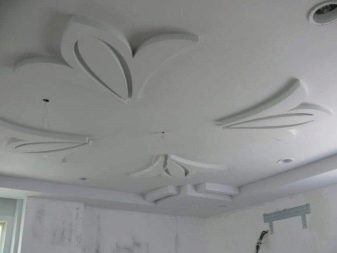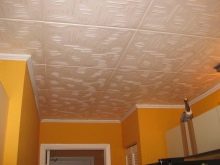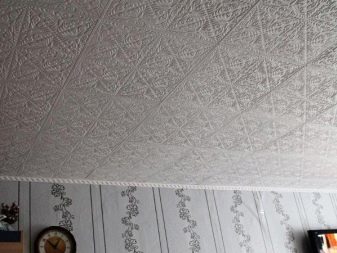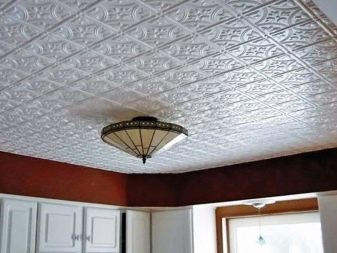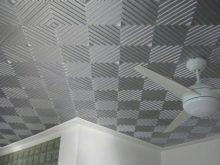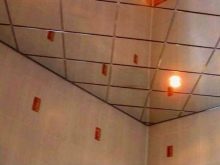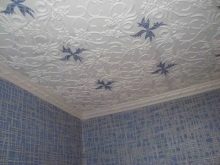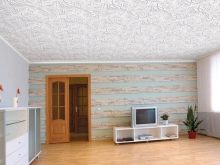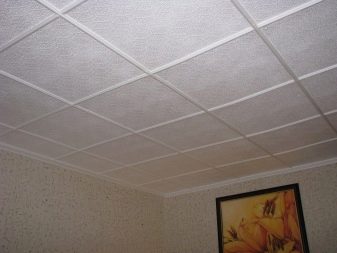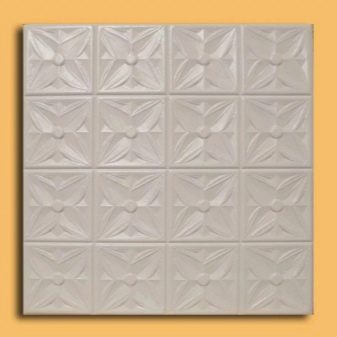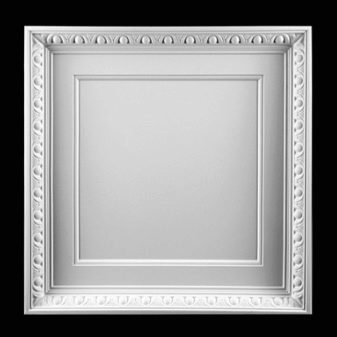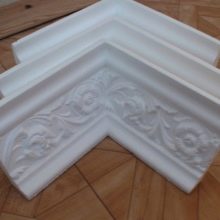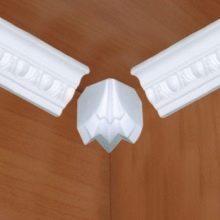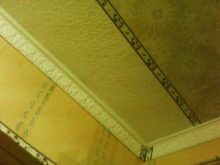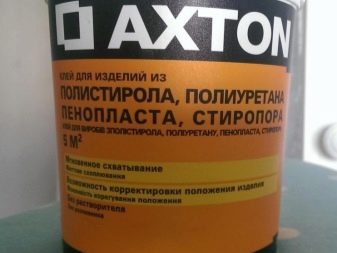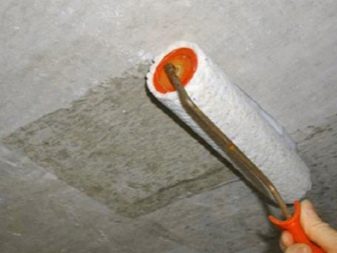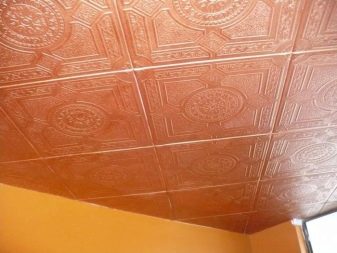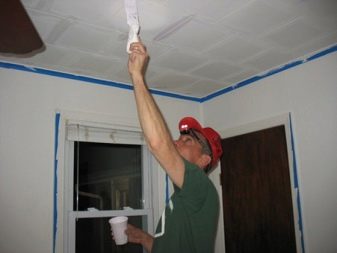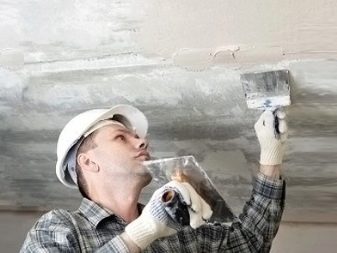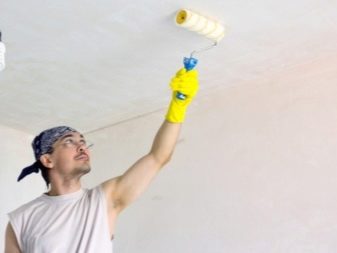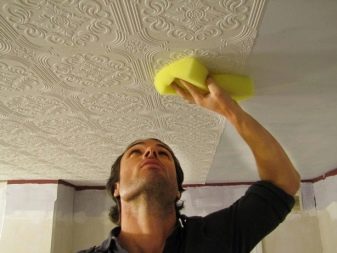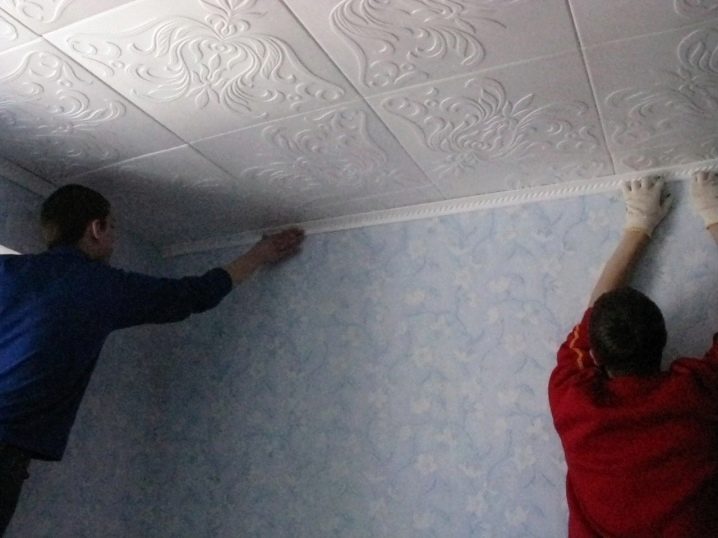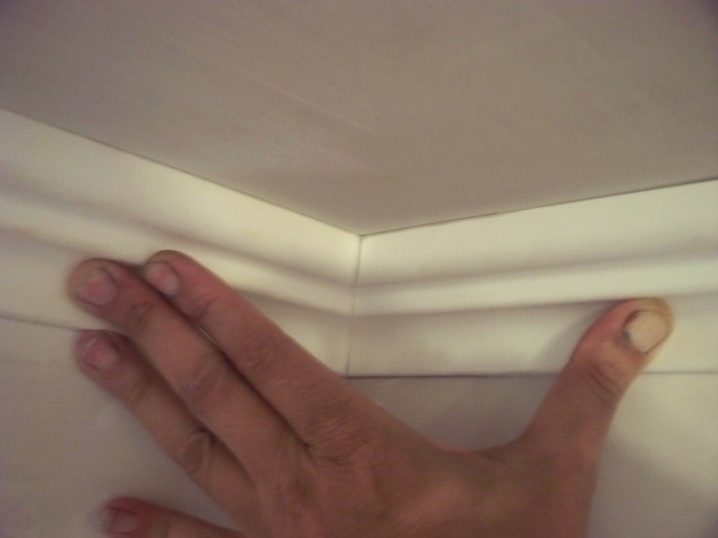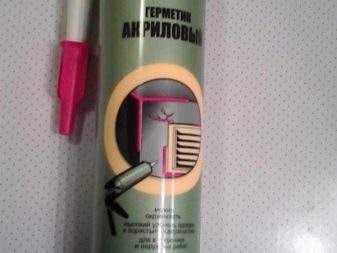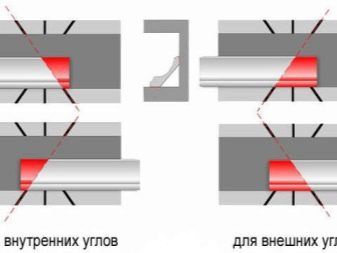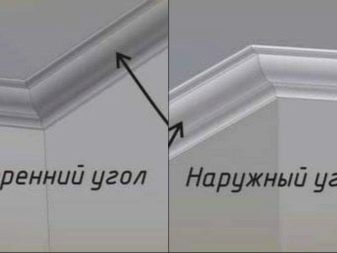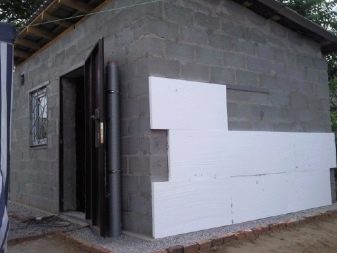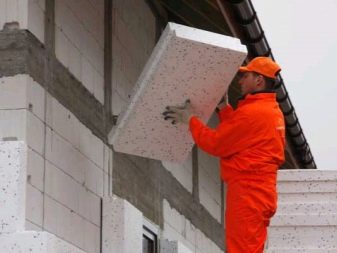The ceiling of the foam: the pros and cons
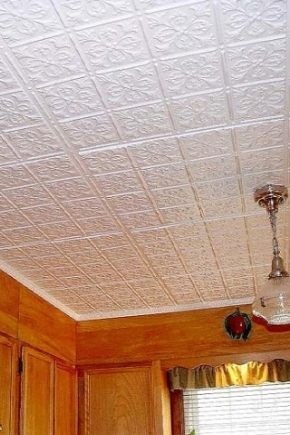
The ceiling of the foam - one of the inexpensive ways to insulate and decorate the ceiling. More recently, such raw materials were used for crafts, today it is a popular finishing material. Today, the foam is presented in a wide range, so you can always find an option that suits your idea.
One of the main advantages of such a ceiling is the fact that the installation can be done independently, without referring to specialists. Consider the features, pros and cons of this material.
Advantages and disadvantages
Through the roof of the room can lose about a quarter of the heat. The tile from polyfoam - unique material which provides the high level of thermal insulation of the room. It is used in cottages, baths, cellars and other rooms.
For example, in private cottages foam coating is one of the most popular solutions. It allows you to save on the purchase of insulation and maintaining heat.
This material is an environmentally friendly product. When it is operated, no toxic substances will be released into the air, it is harmless to health. In the production of molten foam by heat treatment acquires density, increasing its quality characteristics. To obtain a certain tone, dyes are added to the product, providing the material with a bright and saturated color.
The foam has many advantages, we note the main ones:
- Acceptable price. Through this material, you can create an original room decor.
- Low weight. The material can be used for newly erected buildings and old houses. Polyfoam practically does not make heavier a ceiling and walls.
- Large selection of finishing. This may be plaster, plastic.
- Foam resistant to moisture. It can be used for finishing baths, saunas and baths, however in bathrooms need additional waterproofing. The coating withstands large temperature drops.It does not deform in a harsh winter, hot summer. This material gives excellent sound insulation, it is easy to color.
There are foam and disadvantages:
- This material is highly flammable. When applied over a gas stove or column, additional protection is necessary.
- Before insulation of the roof with foam plastic, it is necessary to impregnate wooden elements with antipyrene liquid. Especially it concerns completely wooden constructions.
- The material is fragile. Additional protection is needed: at the slightest damage, the foam begins to crumble.
- Polyfoam cannot be covered with nikrokrakraskoy or varnish. Only water based dyes are applicable.
- This finish is airtight. Due to this, in non-ventilated gaps, there is a high risk of fungus or mold.
How to choose?
To choose this material correctly, it is worth considering a few recommendations.
- It is necessary to pay attention to the corners of the tile. If the shape of the tile is square, all corners should be straight. The slightest deviation will be felt, revealing uneven seams, this is especially important for seamless overlay.
- The edges of the tiles must be smooth, shedding is unacceptable.Good foam does not crumble, if you hold it at one angle. In addition, the picture must be clear, any flaw will be visible on the ceiling with the naked eye.
- Quality material is easy to test empirically: take a tile at one angle and shake. Low quality material will break.
If you decide to insulate the ceiling with foam, you need to know the basic rules by which you can enjoy low-cost and high-quality repairs without the ensuing problems:
- Such coverage requires careful treatment, any dent that has arisen cannot be repaired.
- Avoid joints when laying plates will not work. For aesthetics, you need to use white putty, in addition, remember the utmost accuracy.
- To avoid difficulties with borders in the corners and joints, you can buy ready-made corners, choosing their width as accurately as possible with the main plinth.
- To mask the place of fixing the chandelier, you must buy an outlet in advance.
- Carefully approach to sticking the picture. Already glued material is difficult to redo.
- Think about whether to glue the foam over the stove. The creation of dangerous situations is unacceptable.
- Finishing such material is a good solution when repairing the corridor and the bathroom. But in the bathrooms it is necessary to additionally cover the ceiling with a layer of water-repellent paint.
There are universal adhesives for all types of foam. However, the best tool is a one-component polyurethane adhesive. Its advantage lies in a quick fight, you will not have to stand with your hands up for a long time, holding the tile. Consider the nuance: the cost of glue of different brands is significantly different. If the Russian composition costs about 300 rubles per 1 kg, the Polish glue will be 9000 rubles per 15 kg package. Savings are tangible.
If your ceiling is perfectly smooth and clean, a three-kilogram capacity of PVA glue will suffice. For perfect gluing, it is recommended to add a Moment-Montage white product pack to the solution.
If you live in an old house, it will be wise to additionally strengthen the sheets with dowels with white plastic umbrellas. Then they can be disguised with white putty.
Often the ceiling is uneven, so for alignment you have to use the usual putty.It copes well with the task of leveling, masking cracks. In addition, the putty is a good preparation material: after the surface is treated with a primer, the foam plastic tile will hold stronger. You can combine dry gypsum plaster and PVA glue. The advantage of this combination is the fact that this composition can be putty joints.
Surface painting
Expanded polystyrene is contraindicated aggressive components of dyes, corrosive material. These components include acetone and alkyd additives. For this type of ceiling it is recommended to use neutral water based paints. An excellent choice would be water-based. Today in stores there is a huge selection of colors of this paint.
It will be interesting to look decor in bronze or silver. Such staining is recommended to perform a soft cloth, apply paint to a point: this creates an imitation of aged gypsum stucco. Many choose the bright decor of foam tiles. If desired, the surface can be decorated with a contrasting pattern.
There are several recommendations for the correct gluing of foam sheets:
- Carefully remove the whitewash, old plaster and chalk from the ceiling surface.
- Wipe the base with a damp cloth or almost dry sponge.
- Mark the ceiling.
- Prime the surface with a deep penetration primer.
- Pre-cut the corners of the panels under the sockets of ceiling lights.
- Start from the center and gradually move to the corners.
- Do not forget to give the glue to dry.
- Carefully mask the joints between the panels.
One of the important elements are cornices. This nuance is quite complex in execution, if you have not had previous experience. To facilitate the task, buy light weight decor and powerful glue that will save you from the need of tedious fastening the curb to the surface. The final step is to remove the ink mixture. Do not be lazy to do this directly after sticking tiles, as subsequently cleaning the surface will be difficult.
How to install a plinth?
To plinth firmly grasped, you need to put glue on the eaves and the wall. This is not very convenient, since the consumption of material will be large enough. For more economical consumption, you can apply glue to the baseboard,Attach it to the attachment and let the glue dry. Then you need to press the baseboard tight and hold for two minutes.
Acrylic sealant is the most convenient material. He immediately grabs, such a plinth is enough to hold a couple of seconds. Angular joints - the most difficult task. It is necessary to accurately cut them so that the edges are perfectly matched to each other. To do this, you can use a sharp knife or a special knife for cutting foam. It can be purchased at any hardware store.
Before installing the corners, make a pattern on the floor, noting all the cut lines. Ensure that the corner is tight, there are no gaps. For the best quality interface, you can use sandpaper. Mount for the lamp should not be noticeable. The socket must overlap the wires. The center should be cut along the edge of the decorative glass of the lamp. To do this, you can attach it on the inside and carefully cut a hole.
Fundamental rules
When insulating buildings made of wood is worth considering a few nuances.
- It must be remembered that in saunas foam is rarely used. For example, it is not recommended to cover the place above the boiler with foam, because the material burns at a temperature of 90-95 degrees.
- When finishing the foam cellar and sauna you need to carefully consider the ventilation system. Due to the air tightness of the foam, the walls of the room will immediately become wet (especially during the heating period).
- Do not leave large gaps through which mice and rats can run.
- There is a so-called “thermos effect” when baths and saunas are warmed from the inside. This causes the appearance of mold and mildew, therefore it is recommended to warm such rooms only outside.
The above rule applies to other wooden buildings. Humidity of the room adversely affects the frame of the building, causing rapid decay. All buildings with a high percentage of humidity are strongly recommended to warm only outside. When decorating non-residential foam rooms it is recommended to fix the square of the foam directly to the wall. Remember that thermal insulation of residential buildings requires mandatory installation of the carrier lathing to ensure proper ventilation of the space under the trim.
In the next video you will see how you can make a decor on the ceiling with foam plastic.

